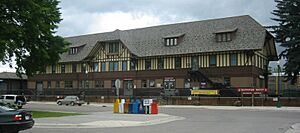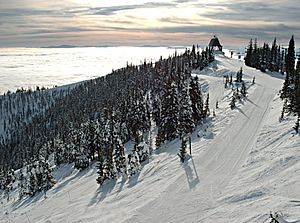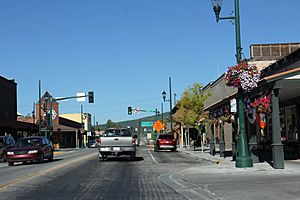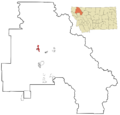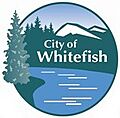Whitefish, Montana facts for kids
Quick facts for kids
Whitefish
|
||
|---|---|---|
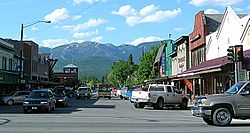
Looking north from downtown Whitefish
|
||
|
||
| Motto(s):
"Montana's outdoor recreation playground"
|
||
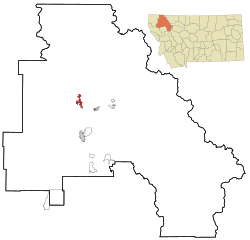
Location of Whitefish, Montana
|
||
| Country | United States | |
| State | Montana | |
| County | Flathead | |
| Area | ||
| • Total | 12.36 sq mi (32.00 km2) | |
| • Land | 6.99 sq mi (18.09 km2) | |
| • Water | 5.37 sq mi (13.91 km2) | |
| Elevation | 2,999 ft (914 m) | |
| Population
(2020)
|
||
| • Total | 7,751 | |
| • Density | 1,109.50/sq mi (428.40/km2) | |
| Time zone | UTC−7 (Mountain (MST)) | |
| • Summer (DST) | UTC−6 (MDT) | |
| ZIP code |
59937
|
|
| Area code(s) | 406 | |
| FIPS code | 30-79825 | |
| GNIS feature ID | 2412257 | |
Whitefish is a city located in Flathead County, Montana, in the United States. Its name comes from the Salish language, epɫx̣ʷy̓u, which means "has whitefish." In 2020, about 7,751 people lived in Whitefish. It's known as "Montana's outdoor recreation playground" because of all the fun things you can do there.
Contents
A Look at Whitefish History
Native American tribes like the Kootenai, Pend d'Oreilles, and Salish used to hunt in the Whitefish area. The Kootenai lived here for over 14,000 years. They lived in the mountains west of the Continental Divide and sometimes traveled east to hunt buffalo.
Early Settlers and Logging
The first permanent settler, John Morton, built a cabin in 1883. It was on the shore of Whitefish Lake. Other logging families joined him in the early 1890s. Loggers used a dam at the river's mouth to collect logs. When the dam opened, the water helped float the logs down the Whitefish River to Kalispell.
The Railroad Arrives
The Great Northern Railway changed its route in 1904. This new route avoided a steep pass and went through what is now Whitefish. This helped the town grow. Whitefish officially became a town in 1905.
The area was first called Stumptown. This was because so many trees had to be cut down to build the town and railroad. Tree stumps were even left in the streets! Early residents worked in logging and for the railroad. The historic Whitefish Depot is still a busy train stop today. Many people use it to visit the ski resort on Big Mountain.
Skiing in Whitefish
Skiing has been popular in Whitefish for over 50 years. In 1937, the Whitefish Lake Ski Club started building cabins and trails. After World War II, two businessmen, Ed Schenck and George Prentice, saw the area's potential. They worked to create a ski resort. Local people helped by donating their time and effort. They prepared the slopes and built a road up the mountain.
On December 14, 1947, the new ski resort opened. Schenck, Prentice, and many townspeople watched the first T-Bar lift operate. This community effort helped create the Whitefish Mountain Resort, which still attracts visitors today. In 2019, a new hotel called The Nooq opened near the resort.
The "Ding-Dong Ordinance"
In 1919, the town started a curfew siren. They called it the "ding-dong ordinance." This historic siren has been restored and is now at the new city hall.
Whitefish Geography
Whitefish is located on the western side of the continental divide. This means that rivers on one side flow to the Pacific Ocean, and rivers on the other side flow to the Atlantic Ocean. The city is also close to Glacier National Park.
Whitefish Lake is a natural lake that covers about 5.2 square miles (13.5 km2). It is about 5.8 miles (9.3 km) long and 1.4 miles (2.3 km) wide. At its deepest, it is 233 feet (71 m) deep. The Whitefish River flows through Whitefish. It eventually joins the Flathead River.
The historic part of Whitefish is called "The Avenues." Many houses in this neighborhood are on the historic registry.
Whitefish Climate
Whitefish has a humid continental climate. This means it has big temperature changes throughout the year. Summers are warm to hot, and winters are cold.
| Climate data for Whitefish, Montana, 1991–2020 normals, extremes 1941–2014 | |||||||||||||
|---|---|---|---|---|---|---|---|---|---|---|---|---|---|
| Month | Jan | Feb | Mar | Apr | May | Jun | Jul | Aug | Sep | Oct | Nov | Dec | Year |
| Record high °F (°C) | 50 (10) |
63 (17) |
74 (23) |
79 (26) |
89 (32) |
95 (35) |
103 (39) |
100 (38) |
94 (34) |
80 (27) |
69 (21) |
47 (8) |
103 (39) |
| Mean maximum °F (°C) | 43.1 (6.2) |
46.8 (8.2) |
59.4 (15.2) |
73.5 (23.1) |
82.6 (28.1) |
87.8 (31.0) |
94.0 (34.4) |
92.8 (33.8) |
84.9 (29.4) |
71.4 (21.9) |
52.2 (11.2) |
41.7 (5.4) |
95.3 (35.2) |
| Mean daily maximum °F (°C) | 29.0 (−1.7) |
33.9 (1.1) |
42.8 (6.0) |
53.2 (11.8) |
63.5 (17.5) |
69.8 (21.0) |
80.6 (27.0) |
80.0 (26.7) |
68.7 (20.4) |
52.6 (11.4) |
37.5 (3.1) |
28.9 (−1.7) |
53.4 (11.9) |
| Daily mean °F (°C) | 22.4 (−5.3) |
25.1 (−3.8) |
32.8 (0.4) |
41.6 (5.3) |
51.2 (10.7) |
57.4 (14.1) |
65.4 (18.6) |
64.1 (17.8) |
54.4 (12.4) |
41.7 (5.4) |
30.8 (−0.7) |
23.4 (−4.8) |
42.5 (5.8) |
| Mean daily minimum °F (°C) | 15.9 (−8.9) |
16.4 (−8.7) |
22.7 (−5.2) |
29.9 (−1.2) |
38.9 (3.8) |
45.0 (7.2) |
50.2 (10.1) |
48.2 (9.0) |
40.2 (4.6) |
30.9 (−0.6) |
24.0 (−4.4) |
17.9 (−7.8) |
31.7 (−0.2) |
| Mean minimum °F (°C) | −7.2 (−21.8) |
−3.4 (−19.7) |
6.8 (−14.0) |
19.6 (−6.9) |
27.2 (−2.7) |
34.0 (1.1) |
40.3 (4.6) |
37.8 (3.2) |
29.4 (−1.4) |
17.5 (−8.1) |
7.0 (−13.9) |
−2.7 (−19.3) |
−14.9 (−26.1) |
| Record low °F (°C) | −26 (−32) |
−27 (−33) |
−15 (−26) |
11 (−12) |
19 (−7) |
28 (−2) |
32 (0) |
30 (−1) |
19 (−7) |
−2 (−19) |
−13 (−25) |
−33 (−36) |
−33 (−36) |
| Average precipitation inches (mm) | 1.84 (47) |
1.26 (32) |
1.27 (32) |
1.61 (41) |
1.99 (51) |
3.20 (81) |
1.40 (36) |
0.89 (23) |
1.25 (32) |
1.45 (37) |
1.70 (43) |
2.07 (53) |
19.93 (508) |
| Average snowfall inches (cm) | 16.5 (42) |
7.0 (18) |
8.0 (20) |
1.6 (4.1) |
0.1 (0.25) |
0.0 (0.0) |
0.0 (0.0) |
0.0 (0.0) |
0.0 (0.0) |
0.4 (1.0) |
8.3 (21) |
21.2 (54) |
63.1 (160.35) |
| Average extreme snow depth inches (cm) | 16.3 (41) |
15.6 (40) |
13.4 (34) |
3.6 (9.1) |
0.0 (0.0) |
0.0 (0.0) |
0.0 (0.0) |
0.0 (0.0) |
0.0 (0.0) |
0.6 (1.5) |
4.3 (11) |
12.1 (31) |
18.9 (48) |
| Average precipitation days (≥ 0.01 in) | 13.3 | 8.8 | 10.2 | 10.0 | 12.2 | 14.2 | 7.5 | 6.3 | 7.5 | 9.2 | 10.3 | 12.5 | 112.0 |
| Average snowy days (≥ 0.1 in) | 9.7 | 5.8 | 4.4 | 1.3 | 0.1 | 0.0 | 0.0 | 0.0 | 0.0 | 0.4 | 4.3 | 9.1 | 35.1 |
| Source 1: NOAA | |||||||||||||
| Source 2: National Weather Service (mean maxima/minima, snow depth 1981–2010) | |||||||||||||
Whitefish Population and People
| Historical population | |||
|---|---|---|---|
| Census | Pop. | %± | |
| 1890 | 640 | — | |
| 1900 | 446 | −30.3% | |
| 1910 | 417 | −6.5% | |
| 1920 | 574 | 37.6% | |
| 1930 | 575 | 0.2% | |
| 1940 | 858 | 49.2% | |
| 1950 | 1,025 | 19.5% | |
| 1960 | 1,519 | 48.2% | |
| 1970 | 3,349 | 120.5% | |
| 1980 | 3,703 | 10.6% | |
| 1990 | 4,368 | 18.0% | |
| 2000 | 5,032 | 15.2% | |
| 2010 | 6,357 | 26.3% | |
| 2020 | 7,751 | 21.9% | |
| U.S. Decennial Census | |||
In 2010, Whitefish had 6,357 people living in the city. Most residents (95.8%) were White. About 2.8% of the population was Hispanic or Latino. The average age in the city was 40.1 years old.
By 2019, the population had grown to about 7,714 people. The median age was 41 years old. The average yearly income was $52,037. The average home value was $364,500.
Arts and Fun in Whitefish
Whitefish is known for caring about the environment. It has many protected trails and forests. The town is also ranked as one of the best places for skiing in the United States.
Annual Events and Festivals
Whitefish hosts many fun events throughout the year:
- Huckleberry Days Arts Festival: This festival features 100 artists and food sellers. There's even a huckleberry dessert contest!
- Taste of Whitefish: For over 25 years, this event has showcased local restaurants. You can sample specialties from more than 25 different places.
- Whitefish Winter Carnival: Held every February, this festival celebrates winter. It includes a parade, a "penguin plunge" into Whitefish Lake, and snow sculptures.
- Under the Big Sky Music Festival: This annual music festival features American music. It takes place on a local ranch with two stages.
- Whitefish Arts Festival (WAF): This festival happens every year over the 4th of July weekend. It features high-quality handmade arts and crafts from artists across the country.
- Whitefish Trail Hootenanny: This event celebrates and supports the public trails around town. It has live music and local food.
- Nashville Heads West: Songwriters from Nashville come to Whitefish for a week. They write songs inspired by Montana's big sky.
Sports and Outdoor Activities
Whitefish offers many sports and outdoor activities:
- Whitefish Trail Legacy Run: This annual race celebrates the public trail system. It includes a 50-kilometer (31-mile) ultra-marathon, a half-marathon, a 10-kilometer (6.2-mile) race, and a 5-kilometer (3.1-mile) race. It happens in early October.
- World Indoor Golf Championship: This is a 9-hole miniature golf tournament held in downtown Whitefish. It has been held for over 16 years.
- Glacier Challenge: This is a multi-sport relay race that covers about 50 miles (80 km) around Whitefish. It has six parts: running, biking, canoeing, and kayaking. You can enter as a solo person, a pair, or a team.
Education in Whitefish
The Whitefish School District serves the city. It includes Muldown Elementary School, Whitefish Middle School, Whitefish High School, and Whitefish Independent High School. Students can also take online classes and earn college credit through Flathead Valley Community College. The sports teams at Whitefish High School are called the Bulldogs.
Whitefish High School has won many state championships. The girls' cross country team has won four titles in a row! Other sports teams have also won state titles, including golf, volleyball, basketball, track and field, tennis, and more.
The Whitefish Community Library is the public library in town.
Whitefish Media
Whitefish is part of the Missoula media market. The city's main newspaper is The Whitefish Pilot. The Flathead Beacon, a regional newspaper, also publishes Whitefish Area News. Three radio stations are licensed to Whitefish: KJJR 880 AM, KSAM 1240 AM, and KWOL-FM 105.1.
Whitefish Transportation
Major roads like U.S. Route 93 and MT 40 go through Whitefish. You can fly into Glacier Park International Airport, which is located along U.S. Route 2.
The Whitefish Amtrak station is served by Amtrak's Empire Builder train. This train travels between Chicago and Portland/Seattle. It is the busiest Amtrak station in Montana. The Stumptown Historical Society owns the station. It was added to the National Register of Historic Places in 2002.
Places to Visit in Whitefish
- Alpine Theatre Project
- Great Northern Brewing Company
- Whitefish Museum, located in the historic depot building
- Whitefish Theatre Company
Notable People from Whitefish
Many interesting people have lived in or are from Whitefish:
- David Booth, a professional hockey player
- Bob Brown, a former Montana Secretary of State
- Murray Craven, a former NHL player
- Adrianne Curry-Rhode, a former model and winner of America's Next Top Model
- Edward J. DeBartolo Jr., former owner of the San Francisco 49ers football team
- Pat Donovan, a former Dallas Cowboys football player
- Kaitlyn Farrington, a professional snowboarder and Olympic gold medalist
- David Graham, a retired professional golfer
- Steve Howe, a former MLB pitcher
- Dorothy M. Johnson, a Western author
- Gary Knopp, a politician who served in the Alaska House of Representatives
- Ross M. Lence, a political scientist and author
- Braxton Mitchell, a politician
- Frank B. Morrison, Jr., a Montana Supreme Court justice
- John Morrison, a Montana state auditor
- Terry Moulton, a politician from Wisconsin
- Jake Sanderson, a professional hockey player
- Brian Schweitzer, a former Governor of Montana
- Constance Towers, a singer and actress
- Maggie Voisin, a freestyle skier
- Ryan Zinke, a former United States Secretary of the Interior
Images for kids
See also
 In Spanish: Whitefish (Montana) para niños
In Spanish: Whitefish (Montana) para niños



